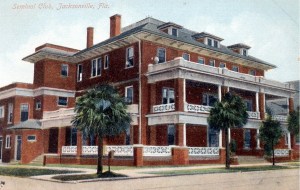by Tim Gilmore, 7/1/2014
Peter Behringer meets me on the wide front veranda of the 1903 building that long housed the Seminole Club and welcomes me into a grand foyer with Prairie Style leaded-glass lights pendant from a dark coffered ceiling. Coffered walls recede inward toward dark pilasters and a wide-arched fireplace.
Peter’s is half the name of Peterbrooke Chocolatier, founded by his mother Phyllis Lockwood in 1983 and named for her children. His is also the name in Sweet Pete’s, the confectionary and candy store in the Victorian neighborhood of Springfield just north of downtown.
Peter’s most recent and expansive fame comes from reality-TV. He’s the “quirky confectioner” with the “fun staff” on The CW’s “Sweet Pete’s: The Show.” More to the point of the grand old downtown building into which he’s invited me, Sweet Pete’s appeared on an episode of CNBC’s “The Profit,” on which wealthy businessman Marcus Lemonis meets with entrepreneurs and helps turn small businesses around.
Lemonis met with Behringer and his wife Ashley, told Sweet Pete’s then-business-partner Dane Baird, in typical reality-TV mock-drama, “I don’t need you,” then agreed to buy the Seminole Club to house Sweet Pete’s and three other producers and sellers of sweet treats Lemonis got to know through his show.
Peter says, “When I first brought Marcus through here, he hated it. He said it was too big and too old and there were ghosts here.” The 111 year-old building contains around 22,000 square feet.
Peter leads me up and across complicated stairwells. We walk through vast open sky-lighted spaces, rectangular bars on second and third floors, a front room with a corroded wide-open Diebold safe, interior basketball and racquetball courts with loudly resounding echoes, adjacent loading and unloading docks, and labyrinthine hallways built to subdivide the original old building who-knows-when.
We pass strange open crawlspaces and dumbwaiters, locker rooms, a sauna, showers, and a steam room.
We walk into attic rooms with ragged old fiberglass installation and boxes piled high on boxes. Lying about randomly are health permits, blank membership certificates, a large framed Happy New Year’s poster, and a cardboard cutout of a chubby man in a vest offering a bottle of Booker’s Bourbon.
The Seminole Club was a place to which came presidential candidates. Theodore Roosevelt gave a campaign speech from the porch to a crowd assembled in the street and Hemming Park. JFK had a coffee here after his Hemming Park rally.
A May 2010 Jacksonville Financial News and Daily Record article quoted former headwaiter Jesse Prince as saying club membership included “the top dogs of Jacksonville,” and saying, “Those were the days.”
But what the building really housed was the good ol’ boys’ network of local political and business elites who squeezed out competition and bought their memberships by being male and white and wealthy.
Women weren’t admitted until 1988 and the club closed one year later. Not only could women not join, but they were not allowed above the ground floor. The third floor contained 15 rooms for “bachelors” and “discreet” and expensive prostitution.
Prince worked at the Seminole Club from 1968 until it closed in 1989. He and the wait staff were black; those they served were white. He compared the club to a fraternity, and of its discretions in the “bachelors’ rooms,” he said, “I’ve got a lot of stories from those days. Most of them I can’t tell.”
Peter Behringer can tell you what he hopes happens next in this building. Sweet Pete’s plans to expand its retail and its catering and Peter seems to take special delight in telling me about school field trips.
He teaches science through teaching the chemistry of making candy, and he’s excited about the new, and very old, spaces in which he can do that here. He can teach history in addition to science in this building, he says, though he does that to a lesser extent now in the two-story 1919 house Sweet Pete’s currently occupies on North Pearl Street.
In 1997, the City of Jacksonville moved City Hall into the formerly abandoned St. James Building, the 1912 masterpiece of the city’s greatest architect, Henry John Klutho, which occupies the city block east of the Seminole Club. What could better replace the good ol’ boys’ club to look straight into the side of City Hall in the St. James Building than a candy maker and confectioner?
My guess is that Peter will tell kids about the presidential candidates who’ve visited, but not exactly how good ol’ boys’ networks in Southern towns really worked.
















Pingback: Seminole Club and Sweet Pete’s All-Natural Confectionary | The Left Turn